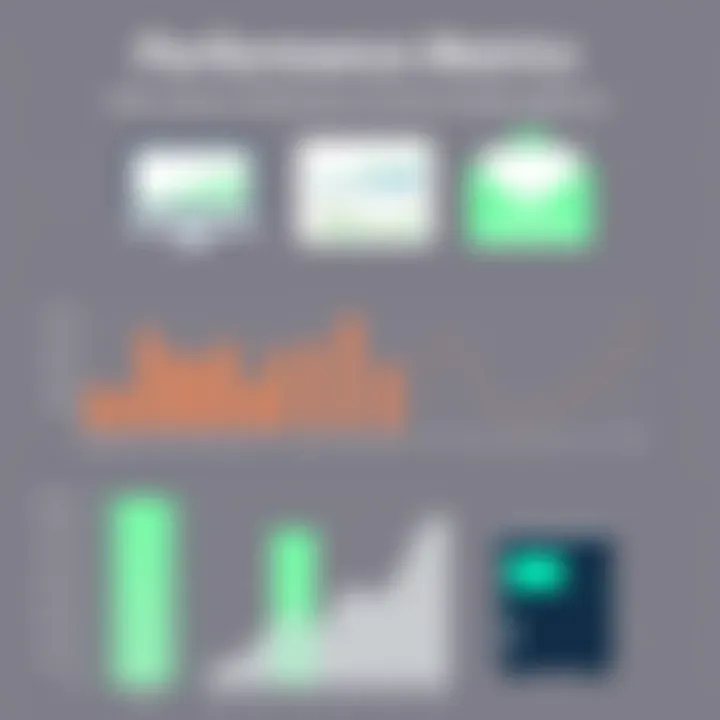Comprehensive Review of Fortinet FortiGate Appliances


Intro
In an ever-evolving landscape of cybersecurity, businesses are under constant pressure to fortify their networks against a myriad of threats. The Fortinet FortiGate appliances have emerged as prominent players in this domain. But what exactly sets them apart from the competition? This comprehensive review delves into the performance, security features, usability, and overall value that Fortune enterprises can derive from deploying FortiGate solutions. The goal here is not just to present numbers and specifications but to unpack these gadgets in a way that speaks directly to decision-makers weighing their options amidst a myriad of offerings.
As organizations increasingly turn their attention to integrating robust cyber defenses, understanding the nuts and bolts of what makes FortiGate tick becomes essential. This isn't purely a question of budget, but rather a quest for assurance in the face of mounting digital threats. So, let’s peel back the layers and explore the core components of FortiGate appliances that make them worth considering.
Key Features
Overview of Core Features
When looking at Fortinet FortiGate appliances, the heart of the matter lies in their impressive core features. These devices come equipped with an array of capabilities that help businesses safeguard their operations. Here’s a closer look at some standout features:
- Next-Generation Firewall (NGFW): Fortinet FortiGate boasts a powerful NGFW that excels at blocking malicious traffic while allowing legitimate data to flow freely.
- Intrusion Prevention System (IPS): A well-tuned IPS protects systems from known vulnerabilities and actively monitors for suspicious activity.
- Secure SD-WAN: Many models include SD-WAN capabilities that enable efficient management of multiple connections and optimized application performance.
- VPN Support: FortiGate provides robust VPN solutions that allow secure remote connections, ensuring that users can work from anywhere without compromising security.
- Advanced Threat Protection: With FortiSandbox integration, users benefit from real-time analysis of files and links to identify emerging threats before they infiltrate the network.
User Interface and Experience
The user experience with Fortinet FortiGate products is another key consideration for businesses evaluating these appliances. The management interface is clean, intuitive, and designed for efficiency. Users who are familiar with network management will find the layout user-friendly, allowing for quick navigation across various settings.
Moreover, the FortiOS operating system integrates the features cohesively, facilitating streamlined operations. This can save valuable time during both the setup and management phases of deployment.
"The user experience with Fortinet FortiGate is often praised for its simplicity and effectiveness, making it accessible for both seasoned pros and those less technically inclined."
Pricing and Plans
Overview of Pricing Models
When it comes to investing in cybersecurity, understanding the pricing models available can influence decision-making. FortiGate appliances offer a tiered pricing structure based on features and capabilities. Typically, customers can choose between a one-time purchase for the hardware or opt for a subscription-based model that may include additional services.
This flexibility allows organizations to align their budget and capabilities more effectively. While entry-level models may appear cost-effective at first glance, organizations should consider total cost of ownership, including licensing fees for software updates and support.
Comparison of Different Plans
A brief comparison can highlight differences in the offerings. For instance:
- FortiGate 60F: This model is often suited for smaller businesses, delivering essential features at a competitive price.
- FortiGate 100F: A mid-tier appliance that balances performance with advanced features, ideal for medium enterprises with greater security needs.
- FortiGate 600F: Targeted at large organizations, this appliance offers high throughput and extensive features, designed for significant infrastructure demands.
Understanding which plan aligns with an organization’s needs is crucial to making the right investment. As cybersecurity continues to gain traction within budgeting discussions, businesses would benefit from a tactical approach to choosing the right FortiGate appliance.
Preface to Fortinet FortiGate
In today's digital landscape, cybersecurity is not just a luxury but an essential component for organizations aiming to protect their sensitive data and ensure operational continuity. The topic of Fortinet FortiGate arises from a pressing need for robust security solutions that comprehension both performance and value. This analysis takes a closer look at Fortinet's security appliances to see how they can meet the ever-evolving cybersecurity challenges.
Overview of Fortinet
Fortinet, founded in 2000, has made a name for itself as a leader in the cybersecurity industry. With its headquarters in Sunnyvale, California, the company specializes in developing high-quality security products designed to protect networks from a variety of threats. The flagship product line, FortiGate, acts as a cornerstone of Fortinet's comprehensive security approach. It integrates various security functions like firewall, VPN, and intrusion prevention into a single platform. This all-in-one solution means that businesses can consolidate their security efforts, potentially reducing complexity and improving efficiency.
The importance of Fortinet in today’s world extends beyond mere product offerings; they provide strategies that align technology with business goals. By keeping pace with the fast-changing threat landscape, Fortinet has positioned itself as a go-to for organizations seeking to fortify their defenses against cyber risks. Notably, the company is also recognized for its commitment to innovation, always striving to improve its products to stay ahead.
What is FortiGate?
FortiGate refers specifically to a line of next-generation firewalls that integrate advanced security features into a single device. Unlike traditional firewalls, which primarily monitor and control incoming and outgoing network traffic based on predetermined security rules, FortiGate systems employ deep packet inspection, enabling them to analyze connections more thoroughly.
These devices operate on a unified security architecture, facilitating better visibility and control across vast and diverse network environments. As organizations look for agile yet potent tools, FortiGate provides the flexibility to adapt to growing needs, all while ensuring robust security controls.
Key features of FortiGate include:
- Next-Generation Firewall Capabilities: Enhanced application awareness and control.
- Integrated Threat Intelligence: Leveraging Fortinet’s FortiGuard services to stay updated on emerging threats.
- VPN Solutions: Secure remote access for employees and partners alike.
- Intrusion Prevention Systems: Machine learning and AI tech bolstering security measures.
In essence, FortiGate serves as much more than just a firewall. It acts as a central hub for security operations, empowering organizations to respond swiftly to incidents and maintain compliance with regulatory requirements. As we delve deeper into the performance aspects and overall value FortiGate delivers, it becomes evident that this is not just a product for IT departments but a resource that can drive strategic security initiatives across an organization.
Key Features of FortiGate


In evaluating Fortinet's FortiGate appliances, it becomes clear that the assortment of features they offer is paramount. These features are not just bells and whistles; they are vital components that shape the effectiveness and efficiency of network security within an organization. Understanding these key features allows business leaders to assess their cybersecurity needs and pick a solution that meets their specific requirements.
Next-Generation Firewall Capabilities
FortiGate's next-generation firewall (NGFW) capabilities stand as a cornerstone of its offering. While traditional firewalls primarily monitor incoming and outgoing traffic, NGFWs go beyond mere packet filtering. They integrate multiple security functions into one device, including intrusion prevention, deep packet inspection, and application control.
This presents significant advantages for organizations. Firstly, by consolidating multiple functions, businesses can reduce hardware costs and simplify deployment. Secondly, NGFWs can identify and classify applications by recognizing behavior, rather than simply relying on port numbers. This capability allows businesses to enforce policies that protect sensitive data more effectively.
Moreover, FortiGate's adaptive capabilities enable it to evolve with the changing threat landscape. As attackers come up with more sophisticated methods, the NGFW can adapt its defenses accordingly, ensuring an organization remains ahead of potential vulnerabilities.
"The integration of next-generation firewall features not only streamlines network security but ensures that companies can respond to emerging threats with agility."
VPN Solutions
A robust virtual private network (VPN) capability is essential for any modern business. FortiGate offers a range of VPN solutions tailored to various needs. Whether it’s site-to-site connections for branch offices or remote access for telecommuting employees, FortiGate provides secure tunnels to protect sensitive data in transit.
The key advantage of FortiGate’s VPN is its ability to maintain high throughput while ensuring strong encryption protocols. This means that users can access vital applications from remote locations without sacrificing performance. Additionally, FortiGate supports multiple tunnel protocols, allowing organizations to choose the methodology that best suits their infrastructure.
Intrusion Prevention System
The Intrusion Prevention System (IPS) embedded within FortiGate appliances is another feature that displays the product's comprehensive security posture. This system actively monitors network traffic for suspicious activity, blocking threats in real-time before they can cause damage.
What sets FortiGate apart is its ability to combine machine learning with threat intelligence. The IPS utilizes patterns from previous attacks to identify anomalies, improving detection rates and reducing false positives. This means that security teams can focus their efforts on genuine threats rather than spending time sifting through noise.
Web Filtering and Application Control
Web filtering and application control are crucial features that enable organizations to oversee and manage internet usage effectively. FortiGate’s web filtering capabilities allow IT administrators to block access to harmful websites, enforce browsing policies, and monitor user behavior. This is not just about security; it also helps in aligning internet usage with corporate ethics and compliance.
Additionally, application control allows businesses to prioritize critical applications while restricting non-essential ones that may consume bandwidth or pose security risks. The granular control FortiGate provides empowers organizations to shape users' internet experience, ensuring business processes are not interrupted by potential threats or inefficiencies.
Performance Evaluation
When it comes to cybersecurity solutions, performance yawns at the forefront of considerations. The performance of Fortinet FortiGate appliances is crucial, as it determines how effectively a network can function under various conditions. High throughput and low latency are the bread and butter for businesses that rely heavily on data transfer and real-time applications. If these aspects do not meet operational needs, organizations may find themselves in a tight spot, jeopardizing efficiency and security at the same time.
In an age where cyber threats evolve faster than we can think, a robust firewall must do more than just block unauthorized access. It has to deliver seamless connectivity and maintain the integrity of data as it traverses the digital landscape. With increasing demands for bandwidth and greater complexity in data traffic, evaluating the performance metrics of FortiGate appliances becomes non-negotiable. Below, we’ll break down the pivotal elements involved in assessing this performance.
Throughput and Latency
Throughput, a significant performance metric, measures how much data can flow through the FortiGate device at any given moment. Simply put, it’s about speed. But that’s not where the story ends. Latency, on the other hand, refers to the delays encountered during this data transfer. It’s like asking how quickly you can check your emails after hitting ‘send’.
A high throughput with low latency translates to an efficient security solution, which is vital for businesses that run myriad applications simultaneously. If FortiGate is handling traffic at a breakneck speed but with a considerable delay, the outcome could be frustrating. End-users will feel the impact when they experience slow loading times or delayed responses from cloud services.
"Throughput and latency are like two sides of the same coin. One without the other can spell trouble, especially in the fast-paced world of business."
Tech-savvy organizations are thus encouraged to scrutinize these metrics during the evaluation phase. Conducting stress tests and simulations within their environments can provide insights into how these FortiGate appliances will perform under real-world conditions. Also, reviewing Fortinet's performance benchmarks is a smart move, as they offer valuable context on the capabilities of different FortiGate models.
Scalability of Solutions
Scalability is another pillar in evaluating Fortinet's performance. As businesses grow and technology advances, the cybersecurity framework must evolve commensurately. A scalable firewall doesn’t just handle current loads; it anticipates future demands and adjusts accordingly.
FortiGate’s architecture supports scaling at various levels—whether it be adding units, upgrading licenses, or expanding capabilities through software. For instance, if a company begins using cloud services extensively, the firewall must accommodate this increased bandwidth without compromising security.
Consider a hypothetical scenario: a mid-sized company relying on FortiGate for basic protection begins to expand its operations internationally. They will require more robust security measures and possibly additional features such as integrated threat intelligence. Here, the extensibility of FortiGate becomes essential. It should seamlessly integrate new functionalities without a hitch, allowing the organization to face increasing security challenges head-on.
To ensure scalability complements performance, a business should assess their growth forecasts and resource allocations against FortiGate's offerings. This kind of future-proofing not only protects initial investments but also enables organizations to adapt to cybersecurity threats that continuously morph with technological advances.
As organizations explore the FortiGate options, understanding these performance factors will position them well to make informed decisions that align with both current needs and future aspirations.
User Experience with FortiGate
User experience can often make or break technology solutions. With Fortinet's FortiGate appliances, understanding how users interact with the interface and the quality of support provided is paramount. Businesses, especially those with complex cybersecurity needs, rely heavily on intuitive tools and resources that let them focus on what matters—keeping their networks secure.


Interface and Usability
When diving into the FortiGate experience, one of the first things to notice is the interface. A well-designed user interface contributes immensely to the ease of use and effectiveness. FortiGate provides a web-based dashboard that is relatively straightforward to navigate. Users can quickly access a variety of features, from security settings to traffic analysis, without the feeling of being buried under a mountain of options.
- Intuitive Layout: The interface boasts a clear and organized structure, making it easier for users new to firewalls to find their way around.
- Customizable Dashboards: Users can tailor their dashboard to display the most relevant information, enhancing productivity.
- Search Functionality: An integrated search tool helps users to quickly locate specific features, reducing the time wasted in manually sifting through settings.
However, like a double-edged sword, an intuitive interface does not mean the absence of a learning curve, especially for features with deeper configurations. Users may need to dedicate some time getting accustomed to certain elements.
Support and Documentation
Having robust support and thorough documentation can be the difference between frustration and seamless security management.
- Comprehensive Documentation: Fortinet provides an extensive library of resources that cover all aspects of FortiGate. This includes everything from installation wizards to advanced troubleshooting steps. This documentation can generally be found on their official site, making it accessible for users whenever needed.
- Active Community: In addition to individual support, there exists a community of users and experts on forums like reddit.com, where individuals share experiences, tips, and best practices regarding FortiGate.
- Technical Support Options: Depending on the licensing option chosen, users can expect different levels of technical support. Some plans provide around-the-clock support from Fortinet’s team, ensuring timely responses to urgent system issues.
Quote:
"An investment in knowledge always pays the best interest." — Benjamin Franklin. In the context of FortiGate, understanding its functionality and having the necessary resources at one’s fingertips can enhance network security significantly.
Navigating through the user experience with FortiGate reveals that the interface's usability, coupled with substantial support options, makes it a viable choice for organizations prioritizing cybersecurity. For decision-makers evaluating FortiGate solutions, investing time in understanding these aspects could translate into better security practices and improved operational efficiency.
Cost Analysis and Pricing Models
In the world of cybersecurity, understanding the cost implications of the tools you deploy is as critical as their performance. The Cost Analysis and Pricing Models for Fortinet FortiGate appliances are pivotal for organizations looking to safeguard their digital assets without breaking the bank. Whether you're a small business or a large enterprise, a clear grip on what investing in FortiGate entails can lead to smarter, more informed decisions.
When diving into the financial commitments required for FortiGate appliances, multiple elements must be considered. Beyond just the sticker price of the hardware, a thorough valuation needs to examine licensing structures, potential hidden costs, and ongoing maintenance liabilities. Today’s decision-makers must see these investments in their totality, recognizing that a well-planned cybersecurity strategy not only mitigates risks but also has a tangible impact on the organization's bottom line.
License Structure Overview
The licensing structure for FortiGate is one of its key characteristics. Fortinet employs a model that offers flexible options tailored to fit varying organizational needs.
- Perpetual Licenses: You pay a one-time fee, gaining long-term access to the product. However, ongoing support and updates require a support contract.
- Subscription-Based Licenses: These licenses typically include all updates and support as long as the subscription is active. They often allow organizations to scale their usage based on need.
- License Bundles: Fortinet often packages its security features into bundles such as the FortiCare and FortiGuard services—providing a more economical choice for enterprises needing comprehensive coverage.
- Usage-Based Licenses: This is for companies looking for flexibility and only want to pay for what they use, making budgeting much easier.
Organizations must also consider how many appliances they will need and the specific features required. A meticulous calculation of user count, expected loads, and geographic distribution can help predict future demands and inform licensing choices.
Hidden Costs and Considerations
While the upfront costs of FortiGate solutions may appear reasonable, savvy businesses often find that several hidden costs can sneak up and bite them later. Here are a few to keep an eye on:
- Installation and Configuration Fees: When deploying FortiGate appliances, engaging professional services for proper installation and fine-tuning can carry hefty fees.
- Operational Costs: Ongoing management may require additional staff training or even hiring new security personnel, especially if your team lacks experience with Fortinet products.
- Regular Maintenance Fees: Although updates might come as part of your license, other maintenance aspects could incur costs, affecting your recurring budget down the line.
- Integration Expenses: If you plan to incorporate FortiGate with existing systems, there may be compatibility issues requiring custom solutions, further escalating your expenses.
"A wise man once said, 'Measure twice, cut once.' In budgeting for FortiGate, it's essential to assess your needs meticulously before diving in."
For additional reading on licensing and costs in cybersecurity, resources from Wikipedia, Britannica, and relevant discussions on Reddit can provide more insights.
Comparison with Competitors
Understanding how Fortinet FortiGate stacks up against its competitors is essential for organizations evaluating their cybersecurity infrastructure. In an industry that constantly evolves with new threats, the ability to compare these products helps decision-makers choose solutions that are not just effective but also fit their specific needs. This section illuminates key comparisons with leading competitors, paving the way for an informed selection process.
FortiGate vs. Cisco ASA
When considering FortiGate and Cisco ASA, it’s crucial to take a look at not only the pricing but also the feature set and performance metrics. Cisco ASA has been a stalwart in the firewall scene, often praised for its robust reliability and ease of integration within Cisco ecosystems. However, FortiGate brings forth a distinct advantage with its integrated security features.
- Performance: FortiGate's architecture can handle much higher throughput, especially when it comes to SSL/TLS traffic, which is becoming increasingly significant as more businesses shift to encrypted communications.
- Security Features: Fortinet fortifies its offerings with advanced threat protection like intrusion prevention and web filtering built into the firewall, while Cisco ASA often requires additional services and licenses for comparable features.
"Choosing a firewall shouldn't just be about which one has the shiniest features; it's about what fits right into your organization's environment and how those features translate into tangible security improvements."
FortiGate vs. Palo Alto Networks
In the arena of next-generation firewalls, Palo Alto Networks often gets the spotlight due to its impressive marketing and innovative features. However, one has to consider certain factors before making an investment. FortiGate’s strength lies in its full security fabric, which combines end-to-end security measures seamlessly, making it suitable for businesses looking for a consolidated approach.
- Cost-Efficiency: FortiGate generally offers a more cost-effective solution without sacrificing performance, which is a vital consideration for budgets, particularly for small to medium enterprises.
- User Experience: While Palo Alto Networks provides a sophisticated user interface, some users report that FortiGate's interface can be more intuitive once you've gotten accustomed to it, making deployment and management less of a headache.


FortiGate vs. Check Point
Check Point has long been a name synonymous with network security, renowned for its advanced threat prevention capabilities. Nevertheless, FortiGate comes with its share of compelling features that could tip the scales for certain businesses. Check Point's strength lies in management solutions; however, FortiGate's price point and performance can prove more favorable.
- Complexity vs. Usability: Check Point products can come with a steeper learning curve, which may affect deployment times across larger organizations. In contrast, FortiGate generally promotes easy configuration and ongoing management.
- Integrated Features: Whereas Check Point might need add-ons for unified threat management, FortiGate combines various security functions in one appliance, simplifying procurement and support.
As organizations evaluate their cybersecurity options, a direct comparison not only highlights FortiGate's competitive standing but also offers insights into how it addresses the unique demands of different businesses. By weighing these elements carefully, decision-makers can align their choice with their organizational goals and cybersecurity posture.
Real-World Applications of FortiGate
Understanding how Fortinet FortiGate appliances apply in various real-world scenarios can illuminate their significance in safeguarding an organization's digital environment. Each business, regardless of size or sector, faces unique cybersecurity challenges. With the rising complexities of cyber threats, choosing the right solution is vital for effective risk management. Let's dive into the practical instances of FortiGate deployments and how they present real value for varied industries and situations.
Case Studies
When considering FortiGate as a potential solution, exploring specific case studies can be enlightening. These narratives illustrate how different organizations have harnessed this technology to bolster their security posture.
- Healthcare Sector: A regional healthcare provider faced stability issues with its network security, often compromising patient data. By integrating FortiGate, the organization significantly improved data protection and ensured compliance with healthcare regulations. They utilized FortiGate's Secure SD-WAN feature to enhance connectivity between locations, delivering secure, reliable access to health data.
- Retail Example: A leading online retailer had to fend off frequent online attacks and not just sum up transactions securely but also protect customer data. After implementing FortiGate's advanced threat protection capabilities, they reported a 50% reduction in phishing attempts and an increase in consumer trust.
- Education Sector Success: A large university installed FortiGate devices to handle increasing cyber threats aimed at its network. The use of Fortinet's integrated security features allowed for better control of user access across the campus network. As a result, their cybersecurity incidents halved in the first year of deployment.
"The strength of your cybersecurity measures can determine the fate of your organization. The FortiGate experience shows this firsthand across sectors."
Industry Use Cases
FortiGate appliances find their application across a variety of industries, each carrying distinct operational needs and threat landscapes. Here, we highlight a few industry-specific scenarios:
- Financial Services: Banks and financial institutions prioritize securing sensitive transaction data. FortiGate protects against unauthorized access while ensuring compliance with stringent regulations. Moreover, it offers lightning-fast performance for secure online banking services.
- Manufacturing: As Industry 4.0 takes over, manufacturers are integrating IoT devices into their operations. Manufacturing plants using FortiGate can not only safeguard their networks from potential breaches but can also streamline operations via enhanced visibility and security management.
- Government Agencies: Government entities often manage vast amounts of sensitive data. FortiGate's firewalls help enforce strict policies while providing real-time monitoring for any suspicious activities, which is crucial in maintaining national security.
Utilizing FortiGate in these varied contexts shows its versatility as a reliable security solution. Organizations can observe substantial improvements in their vulnerability management, thereby fortifying their resilience against evolving cyber threats. Knowing these real-world applications helps leaders make informed decisions driven by practical outcomes and considerations.
Future Prospects and Innovations
As we delve into the realm of cybersecurity, it becomes increasingly clear that the landscape is constantly evolving. The importance of Future Prospects and Innovations in this context is paramount, especially for organizations that rely on secure operations to maintain their competitive edge. For Fortinet FortiGate, understanding future trends is not just a matter of keeping up with technology, but also about strategically positioning their product offerings to address tomorrow's challenges head-on. This section will explore key elements, benefits, and considerations tied to the fast-evolving world of cybersecurity.
Emerging Technologies in Cybersecurity
The cybersecurity sector is on the brink of a revolution driven by several emerging technologies. Staying informed about these advancements can offer significant advantages for enterprises looking to fortify their security posture. Key technologies that are shaping the future include:
- Artificial Intelligence (AI) and Machine Learning (ML): Automated threat detection and response systems enhance the speed and accuracy in identifying potential vulnerabilities while reducing human error.
- Zero Trust Architecture: This approach relies on a "never trust, always verify" principle, making it essential for reducing the attack surface in increasingly complex network environments.
- Extended Detection and Response (XDR): Integrating various security components into a unified analytics platform strengthens the visibility across endpoints, networks, and cloud environments.
- Secure Access Service Edge (SASE): This converged solution simplifies secure access for remote workforces and enforces consistent security policies regardless of location.
Incorporating these technologies can provide FortiGate users with proactive measures against emerging threats, ensuring their cybersecurity framework is not just reactive but resilient.
Fortinet's Roadmap
Looking ahead, Fortinet's roadmap signals a commitment to continual enhancement of its offerings. With an eye on integrating cutting-edge technology, Fortinet aims to provide users with tools tailored to mitigate ever-evolving threats. Notable focal points in their strategy include:
- Enhancing Integration: Fortinet plans to streamline its product suite for tighter integration with third-party solutions, ultimately simplifying the security management process.
- Investing in R&D: A significant allocation is foreseen for research and development to probe into behavioral analytics and predict future attack vectors.
- Incorporating Customer Feedback: Fortinet emphasizes incorporating user insights into product development, valuing the real-world experiences of those using their technology.
- Commitment to Training: As technology evolves, so must the knowledge of its users. Fortinet is dedicated to expanding its educational resources to empower IT professionals and elevate the security competency across organizations.
"The future of cybersecurity is not isolated; it demands a collective effort among industry players, and Fortinet is paving the way forward."
In summary, the future is what you make of it. For businesses employing Fortinet FortiGate, being attuned to evolving technologies and Fortinet’s roadmap can formulate a robust security strategy that not only supports current needs but anticipates future demands.
The End
In this final section, we bring together the myriad threads woven throughout this review of Fortinet FortiGate appliances. The importance of concluding this analysis cannot be overstated. For decision-makers and IT professionals, the ultimate goal of a thorough review is to delineate clear takeaways and actionable insights that can guide future choices regarding cybersecurity solutions.
Summary of Findings
Throughout our examination, we delved into several critical aspects that make FortiGate appliances noteworthy in today's booming cybersecurity landscape.
- Robust Performance: We highlighted that the devices exhibit strong throughput and minimal latency, essential for any organization that prioritizes speed without compromising security.
- Feature-Rich Offering: The multi-faceted capabilities of FortiGate, from next-gen firewall functions to integrated VPN solutions, provide comprehensive coverage against increasingly sophisticated cyber threats.
- User Experience: The usability of the interface and the quality of documentation significantly enhance user engagement, allowing teams to efficiently deploy and manage security measures.
- Cost Considerations: While the initial expense of FortiGate solutions might raise eyebrows, the analysis of hidden costs reveals potential savings in the long run when considering avoided breaches and operational efficiency.
In essence, the synthesis of these findings underscores FortiGate's position as a leading contender for businesses serious about fortifying their cybersecurity posture.
Final Recommendations
Based on our comprehensive review, we propose the following recommendations for organizations weighing their options in network security solutions:
- Assess Your Needs: Before making any commitments, evaluate your organization's unique landscape, including specific threats, compliance requirements, and operational setup.
- Consider Integration: Investigate how FortiGate appliances can complement or integrate with existing systems and processes. Seamless integration can save time and enhance operational efficiency.
- Invest in Training: Ensure that your team is well-acquainted with the features and functionalities of FortiGate solutions. Empowering your team through training can illuminate the true value of the technology in safeguarding your digital assets.
- Plan for Future Growth: Given the rapidly changing nature of cybersecurity threats, select a solution that not only meets current needs but also possesses scalability features for future-proofing your investment.







